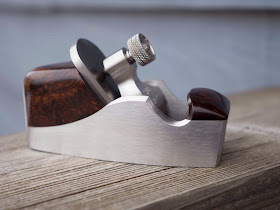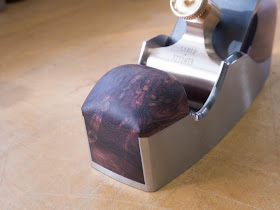The end of 2013 and the beginning of 2014 have been extremely busy - the guitar project was put on hold until I had a chance to get caught up and get ahead a little bit.
I have had the pleasure of working with more stunning Desert Ironwood as well as a new infill material - one I have been looking forward to for a very long time. More on that a little further down.
These are in no particular order. The first plane is a Desert Ironwood filled K7. It is fairly dark Ironwood, but there were several flashes of golden grain, and as the plane was coming together and the shape further refined, it kept getting better and better. Here are the final results.
The next plane is very similar in that it is also infilled with dark Desert Ironwood. This is the last piece of this very dark burl. It was a small piece, but it was a perfect piece of Desert Ironwood and had very little ‘waste’ to it. I was able to get a No.4ss, a SNo.4ss an XSNo.4ss and finally this K4.
( click the image for a larger view)
There was this amazing area of burl clusters along the edge of the roughed out infill set and I had hoped that it would not disappear during the shaping and refining process. Thankfully it didn’t, and the way they follow the curve of the sidewall is marvelous.
This next plane is one that I have been waiting to make for a long time. Nine years ago, I found a small but stunning piece of Ceylon Satinwood - about 2" square and 18" long. It was covered in the most amazing beeswing pattern on both sides and the top had an almost curly figure to it. I had high hopes for the piece and patiently waited for the right plane.
A K4 turned out to be the perfect place to try the satinwood. It is a very small plane - only 4-1/2" long and there is a delicate balance between having enough surface area of the plane to allow the figure to be sufficiently seen and at the same time, not to make something that is so frantic with figure that it defeats the purpose. Like the Desert Ironwood K4 above, this piece of Satinwood had a natural curve to the grain and with some careful orientation and planning, I was able to take advantage of it to follow the flow of the plane.
If anyone is interested, there are 2 more K4’s left in the piece of satinwood.
This next plane is another K7 - infilled with Rosewood. We were in the midst of some serious snowfall and I did not have a chance to get any photos of it on the balcony ledge. This was for a local customer and he picked it up in person which is always a real treat for me. These photos were taken before the french polishing, but the color and grain is so nice, I decided to include the photos anyway.
This was also another new variation for the K7 - steel sides and sole with a bronze lever cap and screw.
This last pair of planes is part of a larger family of planes. They are all infilled with Desert Ironwood from the same piece of wood. One is a Jr. panel plane being 12-1/2" long with a 2" wide blade, and the other is 14-3/4" long with a 2-3/8" wide blade. They have a larger sibling - an 18-1/2" long version.
One of the things I really enjoy with sets of planes is figuring out how to appropriately scale them. It is not simply a matter of adding an extra inch at each end. Well... you could do that, but it would be rather obvious and not nearly as pleasant to look at. Here are several images that I took of the pair of planes followed by a few from the customer who included the 18-1/2" plane. I was really excited to see the 3 of them together to make sure they all scaled well together.
The heel and toe of the planes are a simple but good example of scaling. You can see the 2 different toe treatments above and then the 3 of them together in the images at the end.
Another good example is the tops of the sidewalls where they meet the shoulders of the front bun. On the Jr. panel plane, the shoulder is 1/8" deep. On the 14-3/4" long plane it is 3/16" and on the 18-1/2" plane it is 1/4". It is a little thing, but I really think it helps keep the scale of each plane working better, and also helps them to work well as a family of planes.
I am hoping to spend a couple days to finish the guitars. They are not yet completed, but are so very close. One of them only needs a bit more buffing and then I can start installing the hardware. The other needs a full buffing but is ready for that stage right now. I can’t wait to plug them in and blow up an amp:)






































Nice work as always Konrad, a magical supply of Desert Ironwood you have - keep the amp below 11!
ReplyDeleteYou're a machine, Konrad!
ReplyDeleteNice looking planes!
You're a machine, Konrad!
ReplyDeleteNice looking planes!
The satinwood is remarkable. You are correct, on a small plane the figure pops without being overwhelming.
ReplyDeleteIs there any chance you would share your method for French polishing? I have read your blog for years and heard you reference French polishing, but the French polish method that I am familiar with - rubbing out the finish multiple times with a pad, pumice, etc - well, I can't see that working very well on small curved surfaces.
Also, any word on a potential book of planes?
As always incredible work. That satinwood looks unbelievable. Also, I am amazed at how much depth the polish adds, as witnessed by it's omission. I wonder if there is opportunity for design exploration with a matte (sandblasted?) body paired with an unpolished infill.
ReplyDeleteYou have all the best wood! Someday...(heavy sigh)
ReplyDeleteKonrad You have been a busy man. Loved the Satinwood on the Steel. And the Trio at the end …perfection !!
ReplyDelete